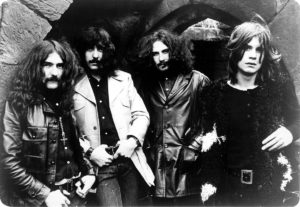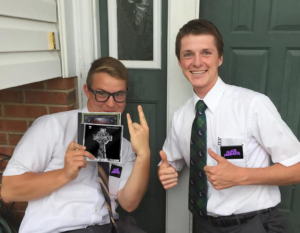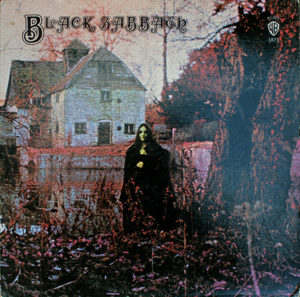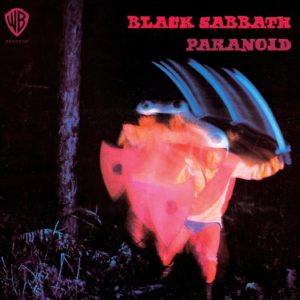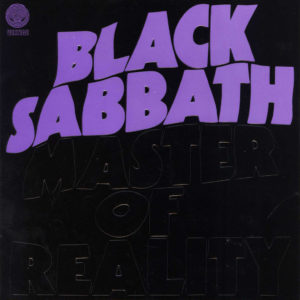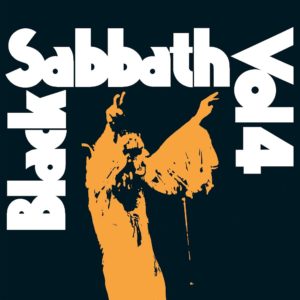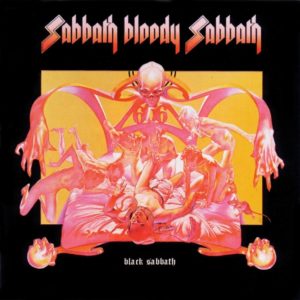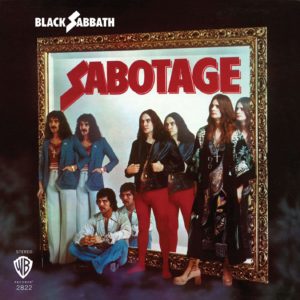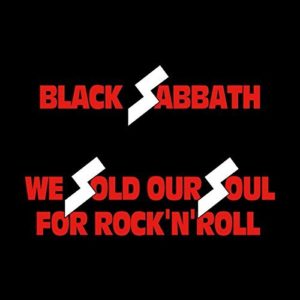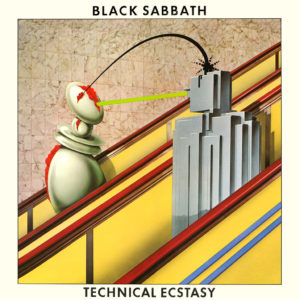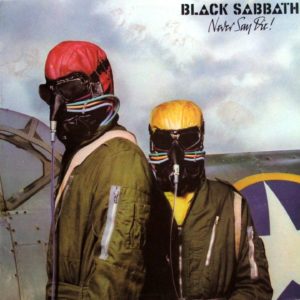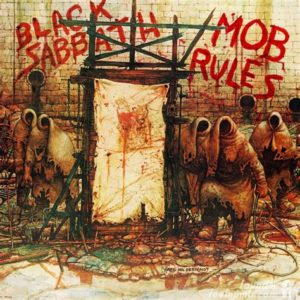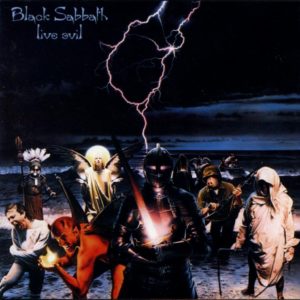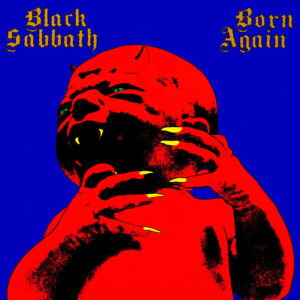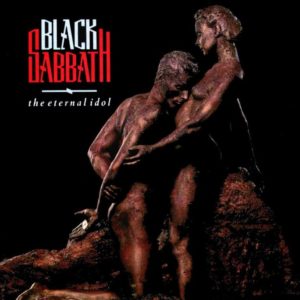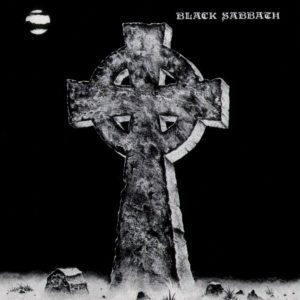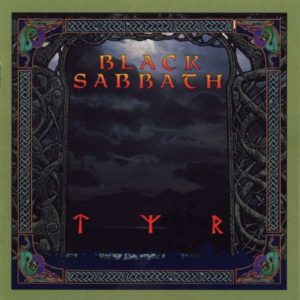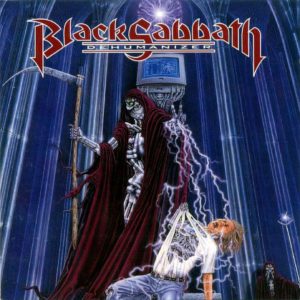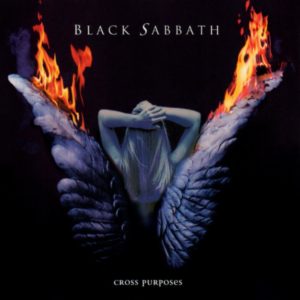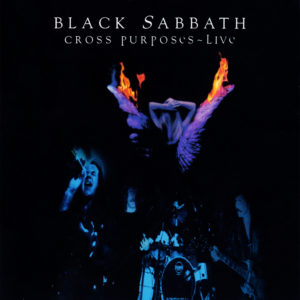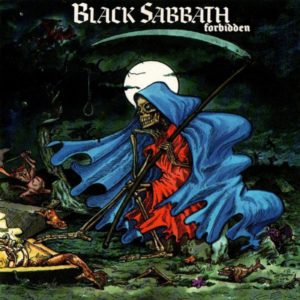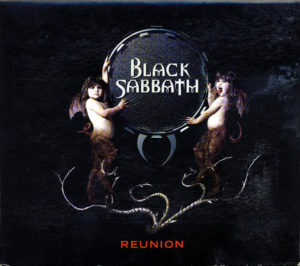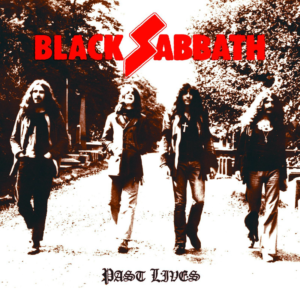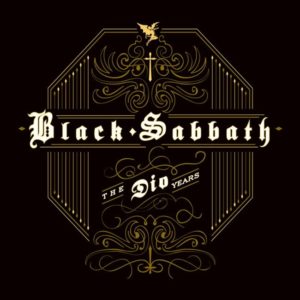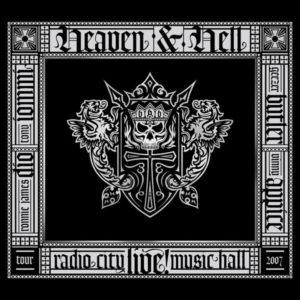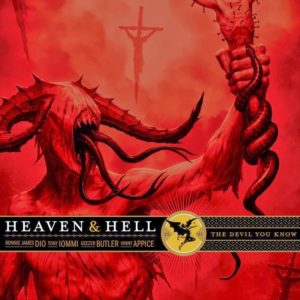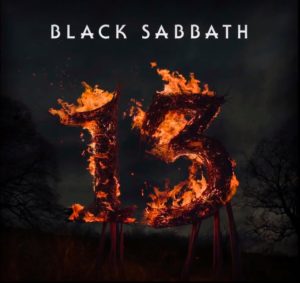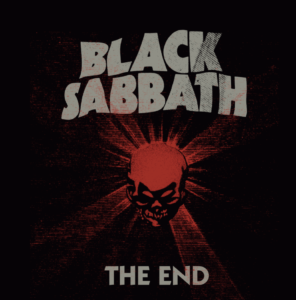You may have heard of this band.
I’d put them in the top five most influential bands of all time, and many people would put them number one on that list. But it’s taken literally decades for that recognition to come. Most people now recognize that Black Sabbath was the band that did most of the heavy lifting to invent Heavy Metal. And they were fucking great.
The first six Black Sabbath albums are required listening for any Heavy Metal fan, or anybody who likes music from that era, I’d say. They stand up just as well or even better than so many albums from bands that hog all the slots on commercial classic rock radio.
But I don’t need to tell you that. What I do need to tell you is that Black Sabbath continued to make great music past the first decade of their existence, and even when it was only Tony Iommi who remained from the original lineup. That’s right, I’m here to proselytize for the proper recognition and appreciation that 80s and 90s Sabbath should receive.
But mostly, I’m going to give my thoughts on the Sabbath albums that have been released over the years. This will be by no means exhaustive, as I don’t have various re-releases with alternate recorded versions or certain live performances, but it will cover all of the official studio releases.
So let’s kick it off at the start.
1970 Black Sabbath
What a debut. I mean, holy fuck. What a way to start. There are no bad songs on this album, at least on the North American release. The original European release had “Evil Woman” on it, which is kind of dull.
But this is definitely part of the classic Sabbath Six Pack. As far as I’m concerned (and as many others will attest) These first six Sabbath albums are unassailable in quality and in sheer ground-breaking awesomeness.
And it took two days to make! Recorded in one, mixed in the other. Amazing. They also nailed the album art on this one. I’ve always been unsettled and a bit freaked out by this album cover, it’s so bizarre and wrong-looking. It’s fantastic for the music the album contains.
My very favourite thing about this album has to be the “professional” critics response to it. They absolutely hated it, and by extension, the band that recorded it. To paraphrase Geezer Butler, the band were totally unknown to the critics and the press, so when this album went into the charts a week after it came out, the critics were caught unawares, and resented them ever since.
Another great thing about this album’s sudden chart success is that when it did enter the charts, and the band were told about this, their response was “What, is there two Black Sabbaths?”
1970 Paranoid
This is often considered to be Sabbath’s best album. I’m going to just state that the entire six pack should be consumed at once (well, maybe in sequence), and that there is an absurdly high concentration of jaw-droppingly amazing metal masterpieces on this album.
But that album cover. I’ve never once looked at that album cover and felt or thought anything but “What the fuck?” The album, you see, was originally supposed to be called War Pigs. So of course, you get some guy dressed in pastel pajamas and a motorcycle helmet, give him a sabre and a pink shield, and take a multiple-exposure photograph of him in the woods. And then you change the title of the album to Paranoid so that the album artwork has no relation to the title anyway.
I think this is a pretty crappy album cover, but hey, the album is stellar and legendary despite it.
1971 Master of Reality
Oh fuck yeah. By far the best 35-minute experience to start off with a coughing fit. This album is heavier and more straightforward than the ones that came before, and also features some down-tuned guitar and bass. Those would become hallmarks of Metal. I love the dry, abrasive sound of this album.
This album was my favourite Black Sabbath album for a long, long time, and it’s still right up there in the number two spot. Ozzy’s voice really came into its own on this album, and some of his performances on here are just awesome, especially on Sweet Leaf.
That cover is not much to talk about, but it’s a step up from Paranoid’s album cover. And the trippy font became somewhat of a band logo later on.
1972 Vol. 4
Ah, Cocaine. This album was actually supposed to be called “Snowblind”, but the record company wouldn’t allow that. It’s still freaking awesome all the way through. Well, almost all the way through. I for one just don’t ever need to hear FX or Changes ever again. Changes is an out of character ballad that tires me out after about 15 seconds. And FX is what happens when too much hashish is consumed in the recording studio.
But the rest of the songs here saw Sabbath expanding what their music was all about, and it worked out wondrously for them. The heaviness was still there when it needed to be, but so were moments of lightness and celebration, new musical sounds and textures and adventurousness.
As for the album cover… it’s pretty minimalist, but I wonder what an album cover dedicated to cocaine would have looked like.
1973 Sabbath Bloody Sabbath
It took me a very long time to appreciate this album. It’s just as high-quality as the rest of the six pack, but this one has a lot of variation in its sound, and in the song structures and general approach.
I understand it now in the context of the time in which it was made too. This was when Prog Rock was massive in England, and it even has a guest performance from Rick freaking Wakeman himself, who spices up the song Sabbra Cadabra.
I’d go so far as to say that every song on this album is great in its own way, which I personally couldn’t about the one before. I’ve seen this one mentioned as Sabbath’s best, and honestly, in some respects, it’s hard to argue against that.
The cover certainly is Sabbath’s best album cover. Make sure you click on that to see the full image. It depicts a man dying in his bed, with demons surrounding him as he dies. He’s dying in the bad way. The reverse of the album had this image on it, which depicts the opposite – a man dying in his bed with his loving family surrounding him as he dies.
Pretty freaking impactful, and as you’ll see, though they would have an interesting and even decent album cover again, they’d never have anything this great on one of their album covers.
1975 Sabotage
The quality of music on this album is inversely proportional to the quality of the album cover. I mean look at it. Look at it!
The idea was pretty great actually, a mirror that showed a “reverse” image. But that photo shows the band in whatever clothes they happened to be wearing (including Bill Ward in his wife’s red tights) because they had been assured that this was something of a “rehearsal” or a “placeholder”, and that the real album cover would have a different photo. Also, there were supposed to be black costumes for them to wear for the actual photo, which nobody bought.
So yeah, there it is. An absolutely ridiculous album cover. But the music on this album! Oh my sweet fucking Jesus you need to hear this album. Stop what you’re doing right now and listen to this album. I’ll wait. Seriously, go get this album right now and listen to it.
Okay now that you’re back… See? I told you! My good god damn, this right here is the best Black Sabbath album ever recorded. And if you got the classic Sabbath six pack that I’ve been suggesting all along, then this is one hell of a way to cap it off.
But by reading up on the making of this album, it shouldn’t have come out nearly as great as it did. The band had fired their manager, who then turned around and sued them. They were trying to get out of shitty, exploitative contracts, and were talking to lawyers, and reading and signing legal documents in the studio almost daily. That’s why the album is called Sabotage, and that’s why there’s a song called The Writ on it.
And according to Ozzy, this album took four thousand years to record. I think he’s being hyperbolic though. And speaking of Ozzy, this right here is his best vocal performance. Holy shit. He sounds possessed on this album! I remember when I was first buying all the Black Sabbath albums, I found this cassette in a record store in BC. I put it into my Walkman, and could not believe the awesomeness that came out of my headphones. Another Sabbath album with no bad songs.
It may even contain their best song, Blow on a Jug. Nah, I’m fucking with you. Their best song is Megalomania.
1975 We Sold Our Soul for Rock ‘n’ Roll
This is a compilation, which was made and released without the band’s knowledge or consent. And of course, due to legal shenanigans, they didn’t make any money from its release either. They only found out about it when fans started asking them to autograph it.
But I include it here because it was my introduction to Black Sabbath. I quite literally wore out my cassette copy of this compilation. It’s got all of the major Sabbath classics from the first five albums, so if you’re looking for a shortcut to Sabbath, and want an abbreviated way in, this would be a great way to go.
And a word on the album cover: worse than Master of Reality’s album cover. Aw man, I fucked that up, that was seven words.
1976 Technical Ecstasy
Oh boy. This is the sound of Black Sabbath trying not to sound like Black Sabbath. This is the sound of Black Sabbath trying to sound like some generic mid-70s radio-ready boogie-based singles band. Foreigner, to be exact.
I remember I’d never heard of this album, despite being a huge Sabbath fan for years, when I saw a friend of mine had a cassette copy. I asked her if I could copy it, and she told me to just keep it.
There’s a lot of finger pointing to a certain mid-90s album when the topic of Black Sabbath’s worst album comes up, and while that album is no masterpiece, I’m gonna lay the laurel of worst Black Sabbath album on this one. Technical Ecstasy is, by far, Black Sabbath’s worst album.
There’s a reason so many people talk about the first six Black Sabbath albums. You might ask “What about the seventh?” This is the seventh album, and it’s just not good.
I’ve tried over years and years and plenty of listens to “get into” this album, but the quality just isn’t there. About four of the songs are alright (pun intentional) and two of them are just awful, with the other two being completely forgettable. Nothing here is great, or groundbreaking. She’s Gone is the worst thing that any of these four guys had ever been involved with, and that’s even considering Ozzy’s embarrassing TV show.
And speaking of groundbreaking… yeah, I think the Sabs are done with that for the most part. You still have to give them credit for basically inventing a whole genre and multiple sub-genres of music in about a half a decade. I kind of glossed over that, but lots of other people have talked it up in depth.
From here out, Sabbath would be playing catch-up, or just plodding along at their own thing. But it was mostly worth listening too.
Oh, and that album cover is actually pretty interesting. It was done by Hipgnosis, and shows two robots having sex. It’s actually the most interesting thing about this album.
1978 Never Say Die!
Well, this is better. This isn’t like the first six albums, except in some spots, but it’s a hell of a lot better than Technical Ecstasy. It was also Ozzy’s last album with the band for a very long time. In fact, Ozzy had quit the band before they made this.
Black Sabbath had found a new singer, wrote new songs, rehearsed and even started recording when Ozzy decided he wanted to be the singer again. But he didn’t want to sing any of the songs written with the new singer.
That’s why Bill Ward sings one of the (actually great) songs on this album, and why the whole set of songs has a kind of “unfinished” quality about it.
But this album also loses points because of the addition of Don Airey’s keyboards on some tracks. Now there’s a sentence I thought I’d never have to write! You see, Don Airey is a legendary keyboardist, and his playing has been a part of some of my favourite songs by my favourite bands for decades.
Yet even though his playing is stellar and spectacular here, it just doesn’t fit. The song Over to You is a perfect example. It’s a nice, upbeat, swinging rocker that goes along just fine until the piano comes in. And the piano part just ruins the feel of the song. I don’t think any piano could have or should have been added here.
It’s so weird because with someone as gifted and as talented as him, he could have added some really awesome dark and doomy organ to some classic Iommi riffs and made something wonderful. But instead we got Over to You.
And over to the album art comment. This is another photo by Hipgnosis, and it’s one of those that reminds me why I don’t like a lot of their album covers. It’s professionally done, but very generic. It could be swapped out for any other Hipgnosis photo album cover, say, this one, and you’d have yourself an equally good album cover. In fact, that photo was what was originally offered to Black Sabbath for this album, so there you go.
1980 Heaven and Hell
So Ozzy’s out. This album marks the definite turning point in the band’s history, and in many fans’ approach to Black Sabbath’s music.
There are those Sabbath fans who maintain that there is no Sabbath without Ozzy. There was actually a long time in my own Sabbath fandom when all I knew were those first six Sabbath albums, and I can even remember in the late 1980s when I was told specifically to avoid anything Black Sabbath was releasing after that.
The conventional wisdom was “Sabbath was good, now they suck!” So I never heard anything from this album or beyond. And I remember working with a guy who was heavy into Sabbath, but only those first six albums Sabbath. We got to talking, and I asked him if he’d ever heard any non-Ozzy Sabbath. He hadn’t so I made him a mix.
He couldn’t believe what he’d been missing. Who needs Ozzy when you have music like this!
But back to 1980. The other three guys in the band weren’t ready to quit either, so they got none other than the man himself, Ronnie James Dio to sing for them. The NWOBHM had become a thing, so lots of other bands had been citing Black Sabbath as an influence. The time had come for Sabbath to make a comeback.
And sweet buttery biscuits (I’m running out of euphemistic superlatives here) did this album deliver. This doesn’t sound exactly like Sabbath of old, but it sounds like a re-invigorated band that has lots of great music to play. And this one is right up there in quality with the first six. I think the songs Heaven and Hell and Children of the Sea might be some of the best they’ve ever recorded.
As an added bonus, it’s got a great album cover. What more could you want!
1981 Mob Rules
This one is very close in style to its predecessor, but there’s a noticeable change. We’re only at 50% original Black Sabbath, for those of you keeping score at home.
Bill Ward had quit the band abruptly while on tour, and luckily for them, Vinny Appice was available and basically the right guy for the job in every way. His drumming here fits what the new Sabbath sound needed perfectly.
Sign of the Southern Cross is an other indisputable Sabbath masterpiece, and Turn up the Night and The Mob Rules are awesome in their own ways too. All in all, another great collection full of freshness, energy, and drive.
This incarnation of the band was powerful, and had great musical chemistry together on tape and on stage, but sadly, it wasn’t to last.
And that album cover? Fucking nuts, I love it.
1982 Live Evil
Live albums don’t often do it for me, and this one’s kind of “meh”. There’s nothing really wrong with it, and it’s got great performances of many of Sabbath’s best known songs, but I can do without it.
However, it is notable for being the reason why Dio left the band in 1982. While this album was being mixed, Dio was often the only band member in the studio with a sloppy drunk recording engineer. So Dio would ask him to play back songs on the desk with different levels so he could hear things differently. He would mostly do this with vocals, so he could hear his own work more clearly.
Keep in mind, this wasn’t mixing, this was just playing back the tapes to hear. The recording engineer then told Tony Iommi some drunken story about how Dio was mixing the album without him, and mixing his vocals higher in volume. Arguments and denials ensued, and Dio left the band, taking Vinny Appice with him.
What a stupid fucking thing to break up a band over.
That album cover is kind of iffy too, could have been done better, I think. But it gets a B+ for effort.
1983 Born Again
(shrieking demonic laughter) AGH-HA-HA-HA-HA-HA-HA-HAAAAAA!!!!
You either love this album, or you hate this album, and I freaking love this album. With 75% original Sabbath once more, thanks to Bill Ward returning on drums, and the addition of Deep Purple vocalist Ian Gillan, what’s not to love?
This incarnation of the band was put together “on paper”, according to Toni Iommi. The suggestion was made to get Tony, Geezer, and Bill back together, and include Ian on vocals for something of a super-group. The next thing you know, everybody’s drunk making this album for the next several weeks, and it’s Black Sabbath again.
Everybody had a great time making it, though, and there was no tequila, I mean there was a party atmosphere through the whole thing. There wasn’t a tremendous amount of detail paid to things like recording quality or fidelity, and I’ve read that either there was a problem with the studio equipment or the master tapes were improperly stored before the album was pressed.
But the result is a kind of low-fi, almost punk sounding metal barrage of screaming, guitars, drums, thrashing, and oh my god its glorious. But you kind of have to like Ian Gillan’s vocals to like this, and he really, really goes overboard with the screaming on this one.
There are some really heavy, killer tunes on this one though, like Zero the Hero, and Disturbing the Priest. I would recommend this album to any curious Sabbath fans too, but of course I’m going to say that about all of them.
The album cover is just as divisive as the album itself, and you either love it or you hate it. I, of course, love it’s over-the-top garish evilness. It’s so ugly and wrong and nasty. Beautiful. I can just see Tony Iommi seeing that for the first time and saying “Woah! Okay, take that to the printers!”
1986 Seventh Star
It’s important to note what it says on this album cover: “Black Sabbath Featuring Tony Iommi”. This is the point where I consider Sabbath to have morphed into Tony’s solo career. And if Tony is to be believed, this album was supposed to be the start of just that, his solo career. But the record company wouldn’t release it unless the more famous Black Sabbath name was on it.
So we’re down to 25% original Sabbath now, and the album cover represents that rather fittingly. But I needn’t remind you that this is the 25% that wrote all those riffs. I will now quote them.
DUN DUN DUN DUN DUN DA DA DA DA DA DA DA DUN DUN DUN
DUN DUN DUN DUN DA DA DUN DUN DUN DUN
DA DA DA DA DA DA DA DA DA DA DUN DA DA DA DA DA
DUN DUN DUN DUN DUN DUN DUN DAAAAAA DUN DUN DUN DUN DUN DUN DUN DA DAAAAAAA
Case fucking closed.
Anyway, riffs weren’t all this man was about. This is the album where Tony Iommi went from Riff Godfather to full-fledged Guitar God. Damn! Listen to those solos! From this album onward, Tony’s solos would often be some mind-bending, eyeball-melting stuff.
And as an album, this is pretty great in its own way, even though it takes a bit of a sonic departure. You might think of the way that Technical Ecstasy did that and faceplanted, but the songs here are actually good, and the performances are also good, especially from Tony and Glenn Hughes.
Glenn was another ex-Deep Purple singer that Tony brought in, originally as one of many guest vocalists on this album, but he ended up singing on the whole thing. And for as much as I’ve joked about the way he sang live with Purple, Glenn Hughes had (and still has) an amazing, unique and powerful voice. It’s often his vocal performance that pushes these songs over the edge for my tastes.
There is a bit of that mid-80s production here, and some of the songs are a little bit on the blues-based side, but hey, do you remember the first Sabbath album from 1970? That had blues influences all over it! I think this album fits in perfectly fine being called Black Sabbath. In for the Kill and Seventh Star are two standout songs for me, so if you’re wondering what this all sounds like without getting the album for yourself, check those out.
1987 The Eternal Idol
This album is where we get to hear Tony Martin on vocals for the first time, on this first of five studio albums he recorded with Black Sabbath.
It’s clear from the moment he starts singing that his voice is what this band’s new “updated” (again, lol) sound needed. That’s right, Sabbath is back with a new lineup, and a new sound for the late 1980s. This isn’t ground-breaking or genre-defining, but this is good and often great metal done by one of the guys who was there from the start.
There’s been a shift in focus from chugging heavy riffs to melodic lines, and Tony Martin’s voice is agile and clear enough to really make that work. I don’t think even Dio with all his talent, skill, and range could have made this kind of music work like it does with Tony Martin singing, and I’m sure Ozzy couldn’t have.
The metal here on these albums is unique in Sabbath’s catalogue, and I think it’s great enough to be listened to by every Sabbath fan. Don’t just dismiss it as “hair metal”.
As for this album in particular, it’s often dark and brooding, yet sweepingly grand and rousing. It’s dramatic and bold, yet sometimes just rocking and fast. If you’re in the mood for this kind of music, then this one is great.
The album cover is pretty interesting too. It was originally supposed to be a photo of this sculpture by Auguste Rodin, also called The Eternal Idol, but permission was denied to use it.
So two models were painted in bronze paint and photographed. Same effect, I guess, except they had to be hospitalized because the paint was toxic. Oops.
1989 Headless Cross
I can’t decide if this is the best of the Tony Martin Sabbath albums, or if it’s the next one. Sometimes I like The Eternal Idol more, actually, but that just goes to show you how good these albums are. And they’re out of print! And nobody’s heard them!
This is the album that I distinctly remember being told to avoid when I got into Sabbath so long ago. I remember when it came out, I was confused. Sabbath was a band from the past, from the dark and distant 1970s, yet they had just released an album. I’d even seen a new video for a new Black Sabbath song on MuchMusic.
Well yeah, I understand it now. And screw those people who told me that Sabbath sucks now. And screw whoever wrote “Black Sabbath Sucks” on that bus stop outside high school.
This album is fan-freaking-tastic. Not one bad track on it, and two all-time classics in Headless Cross and Nightwing. The latter’s vocal performance is in fact the first take, which is pretty damn impressive.
You’ve also got the legendary Cozy Powell on drums on this album and the next, which notches things up a tad too, so this one is definitely peak latter-Sabbath if you ask me.
And even the album cover is pretty good, I’d rate it a solid B.
1990 Tyr
A concept album! Except it isn’t a concept album. Some of the songs on this one are based on Norse mythology, so it’s like… uh… a half-concept album.
But I think this one is a bit more ambitious and a little more daring than the two that came before it, and I think I like it more for that reason. It also opens with one of my all-time favourite Black Sabbath songs Anno Mundi. It also has the almost “prog-metal” suite Battle of Tyr / Odin’s Court / Valhalla. And glancing at the contemporary “professional” reviews of this album, I see more evidence for my theory that most professional record reviewers are, in fact, deaf.
There’s not much more to say about it other than if you liked The Eternal Idol and Headless Cross, you will like this one too. This one is stronger in a lot of ways, and more rewarding on repeated listenings.
Its album art is quite nice, I think, with the kind of runic art that would later get overused and misplaced everywhere because of its cool factor. But it’s kind of appropriate here, you know?
1992 Dehumanizer
(phone rings) “Honey, can you check in the kitchen? I think I left the Dehumanizer on again.”
Hey everybody, Black Sabbath is back!
I remember hearing that when this came out. Thing is, though, Black Sabbath never went anywhere to begin with. I’m sure that statement was a surprise to Tony Martin, Cozy Powell, and Neil Murray.
But that’s what you get when you’re basically Tony Iommi’s backing band. Tony Iommi is Black Sabbath, for all intents and purposes, so if Tony Iommi wants to just switch up the band lineup completely to what it was 10 years ago, well…
It wasn’t exactly like that, and you can read about the way the previous lineup came back into place here. But in any case, yeah. The Mob Rules lineup is back and they hardly missed a beat. This sounds just like the next album in sequence from Heaven and Hell to Mob Rules.
And it’s fucking good. Man, is this some collection of brutal, heavy, smashing riffs. Great melodies too, thanks to Dio and what he could do with a vocal line. With the four of them together again, we really get to hear that particular chemistry they managed to re-capture in the beginning of the 1980s.
There are plenty of great songs on this one, and it was followed by a tour which gave – yet again – a catalyst for Dio to leave the band. Sabbath were asked to open up for Ozzy Osbourne, and Dio refused. There are quite obvious justifications for that, you’ll find them if you search, and I don’t disagree with that.
Dio was out again, and he took Vinny with him again too.
So let’s talk about that album cover. Gosh, that’s striking. It’s pretty fucking cool, isn’t it? I mean it’s not red demonic baby on a blue background cool, but it’s something!
1994 Cross Purposes
Hey, Tony Martin’s back! And Geezer is still around from the previous album’s lineup, so that’s 50% original Sabbath on this one. Some would say that gives this album an edge over the other Tony Martin albums, but I don’t think this one is quite as good as the three that came before.
It has a blending of styles, from the melodic and dramatic metal of The Eternal Idol, Headless Cross, and Tyr, with the more direct and blunt riff metal of Dehumanizer. I’m not really a fan of the result, but I don’t think it’s a bad album.
By listening, you can tell that Tony Martin’s voice has changed slightly though. His tone has become a little different, and there is a little more grit, and less clarity in his singing.
There are some really great songs on this one too, of course, like I Witness, Psychophobia, and Dying for Love. Psychophobia really burns it up, as it’s about David Koresh. Ah, memories.
The album art is kind of striking and generic at the same time, somehow. And it’s another one of those album artworks that was shopped around to different bands for album art, and in this case, it was used by two bands for two different album covers. The Scorpions used it for a single a few years earlier.
1994 Cross Purposes Live
This is a live set that was recorded on the tour that followed. It’s actually pretty good, for what it is, and it’s the only official release that lets us hear how Tony Martin sounds on the Ozzy and Dio era Sabbath songs. It’s not essential by any means, but by its nature, it’s got some live versions of songs you wouldn’t’ expect to hear on any other live Sabbath album.
And that cover… I guess it’s better than a plain manila wrapper.
1995 Forbidden
Now this is what is often considered to be the worst Black Sabbath album. And it goes as far as suggestions to not even bother with it.
But as I’ve already told you, Technical Ecstasy is by far the worst Black Sabbath album, and that can be proved with math!
Well, no, actually it can’t be proved, but just trust me. This one isn’t as bad as its reputation would lead you to believe. But holy unfathomable hell, does it start off with the two worst songs to punish you for daring to listen to it.
Right off the bat, you’re subjected to Illusion of Power and Get a Grip. Oh man, these are awful. Still not as bad as She’s Gone, but god damn, they’re in “worst songs ever recorded by Black Sabbath” contention.
Illusion of Power has no redeeming qualities. It’s just awful, boring and cringe-inducing in every way. It can’t be fixed. It can’t be re-done or re-mixed to make it better, it should have just been omitted. Get a Grip might have been saved by a different vocal approach, or maybe by being turned into an instrumental. I’d say chop it too, because there was actually a better song they could have used that was included on the Japanese version of the album.
So don’t feel bad if you’re just in an “Oh my fucking god I hate this album, it sucks” mood when you first hear it. I think those first two songs were constructed to make you hate music. But it gets better, or at least, the songs get better.
Can’t Get Close Enough, Rusty Angels, and Forbidden are actually good songs. There are some other highlights too, and of course, Tony’s playing is great throughout. And this is the same band that recorded Tyr, so they should have been able to record something equally as grand.
But there was something disruptive looming in Sabbath world, and that was the “reunion” with the original lineup. Only Tony really knew it would happen, but because of that, the whole writing, rehearsal and recording of this album was sloppy and rushed.
And this album is also infamous for its production. Good lord, this album sounds awful. Levels are all over the place. Everything sounds dull and lifeless. Fans have been clamoring for a remix for ages, and I’ve been reading about a theoretical, possible, upcoming remix of this album for over a decade. It’s supposedly finished, but just not quite released yet. We’ll see.
Until then, You might as well listen to whatever version you can find. Just remember to find that extra bonus track, and definitely skip Illusion of Power. Seriously.
Now, about that album art. Okay, that’s bad. And not in the way that the cover to Sabotage was so bad it was good. It’s cartoony and gaudy, but not in the way that the cover to Born Again was so awful it was brilliant. No that cover is just wrong.
Maybe it might have been better if the bright colours were muted and the ground darkened, perhaps like this. But honestly, I think it should have just been something else.
1998 Reunion
Most of what I remember when this album came out was hype. They’re back (again)!
This time the indicator was at 100% original Sabbath, and there would be a tour, a live album (which is what this is) and a brand new album from the original lineup.
Well, we got the live album, which is actually really fantastic. Everybody really does sound happy and excited to be back together on stage again. If you also followed Ozzy’s career, you know that Ozzy loves to be on stage and work a crowd, so this kind of sounds to me like the merging of the Ozzy show with the Black Sabbaths.
It’s kind of odd for that reason, but that might just be perception. It’s still a lot of great music, and hearing all these old classic Sabbath songs again reminds me of why I love that band in the first place. Except Dirty Women. Who thinks that’s a good song?
There are two studio tracks from the failed attempt at a studio album that they were aiming at, and one of those tracks is excellent. Psycho Man stands up well with anything in the Sabbath catalogue, and Selling My Soul is kind of nice to hear too. I would have loved to have gotten a full album as good as anything like the first six from these four guys again, but it wasn’t to be.
And the album art? Typically evil, twisted shit.
2002 Past Lives
This one is a solid live release, and probably good enough to earn the tag “essential”. It contains the entirety of the quasi-official Live at Last album released by their old management in 1980, and an entire second disc of other great recordings from various performances. This all focuses on the years that Ozzy was in the band, so it’s all classic Sabbath from the Six Pack. The only thing dragging down the experience is the sound quality in some spots, but that’s a minor nitpick.
And the cover is what it is. I kind of wish they had at least commissioned some interesting art or something other than a band photo.
2007 The Dio Years
This is a compilation, and as you would expect from the title, it focuses on those albums which featured Ronnie James Dio as the band’s singer.
As a compilation, it serves its purpose well – providing an encapsulated sampling of what this incarnation of the band was all about over the course of those albums. But this one has something special on it, and it has a significance to it because of that.
There are three “new” songs on this compilation: The Devil Cried, Shadow of the Wind, and Ear in the Wall. Those songs are all really, really good, and I think The Devil Cried is a fricken masterpiece. And the four guys who recorded those songs (the Mob Rules and Dehumanizer lineup) had such a good time of doing it, that they decided to re-form and make another Black Sabbath album.
More about that later. In the meantime, these three songs are well worth seeking out, and this compilation is a pretty nice one to have for that reason.
The album art is stylish and well done.
2007 Live from Radio City Music Hall
The band is now called Heaven and Hell, but come on, this is still Black Sabbath. This is Tony Iommi, Geezer Butler, Ronnie James Dio, and Vinny Appice. And this live album was recorded on a tour to promote their re-formation and their best-of compilation release. And even though these guys were all in their 50s and 60s when they played these shows… wow man. They had more energy and drive than some bands half their age.
This is a great document of this version of the band at that late stage of their career, and I think it’s well worth checking out.
I even like the cover art, although it makes me think of Apple II screen graphics for some reason.
2009 The Devil You Know
Well, shit. Now this is a heavy blast of metal. This is also a Heaven and Hell album, although it’s definitely Black Sabbath. It fits right in with the albums Heaven and Hell, Mob Rules, and Dehumanizer. This one is darker and heavier, but it has some flaws.
First of all, it’s too long. That might seem like an odd thing to complain about, but it’s over 53 minutes long, and I maintain that the sweet spot for album length is about 40 minutes. There are a couple of songs that aren’t really that special, and I think they could have been omitted to make this an overall stronger album.
The other flaw is something that afflicts way too many albums of all genres from this time, and that’s “The Loudness War“. (Not to be confused with Record of Lodoss War.)
The audio throughout this album was mastered overly loud, and though it’s not excessively clipped, it is highly compressed as a result. And that really, really makes it sound bad. It’s kind of paradoxical how a naturally loud and distorted genre like metal can be ruined by being distorted and loud, but there you go.
I’ve never found this an easy album to listen to, because the sound just never abates. Overly compressed audio makes the quiet parts too loud in relation to everything else, and it’s exhausting to listen to. So I used an audio editor to try to fix this. First, I reduced the overall volume using a “clip restoration” filter. What that does is to lower the volume level, and then fix broken audio peaks by extrapolating where they should naturally have been, and reconstructing them.
It works pretty well, but that’s only the first step. Next, I use an audio expander plugin (which is the exact opposite of compression) to try and reverse the effects of that audio compression from hard limiting during mastering.
It’s not perfect, but to my ears, the results are way more natural sounding and listenable than what’s on the original CD. A proper way to fix it would be a legitimate remix without compressing and mastering too loud in the first place.
But until that happens, this one is definitely a gem in the Black Sabbath catalogue, even though it’s not actually labeled Black Sabbath. Songs like Atom and Evil and Bible Black are yet more instant Dio-era classics.
And how about that disturbing, evil cover! Yikes! If you were to point to a picture of evil…
2013 13
Well, we waited about a quarter of a century for that complete 100% original Black Sabbath lineup reunion album, and we finally sort of got it. Bill Ward is missed on this one, but hey, Ozzy, Tony, and Geezer are all present and accounted for. And the drummer from Rage On Behalf of the Machine.
And I’m kind of split on how I feel about this album. The whole drama show about how Bill was mistreated and slagged-off in the lead-up to the recording of this album wasn’t very pleasant to witness. And sometimes when I listen to it, these songs sound more like a paint-by numbers reconstruction of Master of Reality and Paranoid. But there are some really good songs on here, and some really good performances, and the more I listen to it, the more I like it.
This one was another album that might just be one of the worst Loudness War casualties, and it took even more drastic measures in my audio editor to get it sounding better. But it’s sounding better now, and it’s easier to appreciate each individual instrument and voice after I’ve reversed some of the damage from that compression.
I think this one is worth acquiring too, of course, if not for the fact that it’s the official end of the road for Black Sabbath. The album proper (eight songs without bonus tracks) ends on a nicely executed “bookend” effect, with rain, thunder, and church bells chiming in the distance. Cool.
Now, about that album art. It’s a photo of a giant wicker “13” burning out in a field. I can appreciate the effort, but I really feel ambivalent about the title of the album in the first place, so I can’t exactly get excited over such a grandly executed scheme to make an album cover depicting a pair of numerals. At least it’s not someone in pastel pajamas, I guess.
2016 The End
This one’s an oddball. The only physical versions of these were sold at Black Sabbath shows during their final tour. And it contains four unreleased songs from the 13 sessions, and four live tracks recorded from that tour.
That cover is pretty cool, too. I like it better than the grandiose, overworked album art for 13.
It’s an alright listen, but I’m kind of wondering why they didn’t just release the eight spare tracks from the thirteen sessions. That would make for a 44-minute album right there. I would suggest listening to this one as a compilation of those eight studio-recorded songs, in fact, with the four live ones omitted. I feel that makes both the album 13 and this one a better listening experience.
In any case, this one really, officially, is The End.
